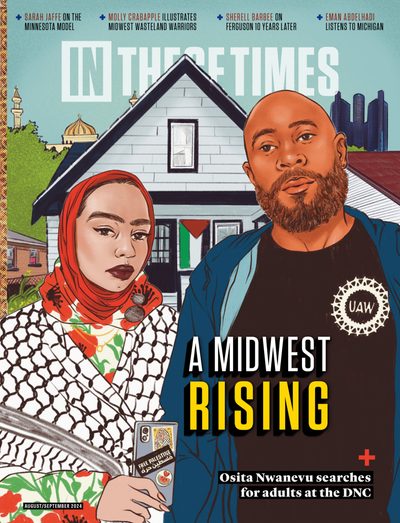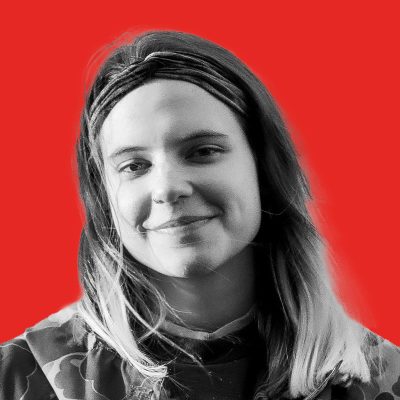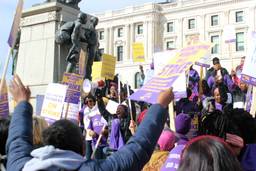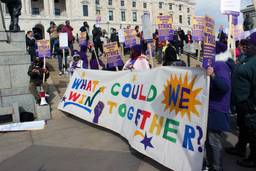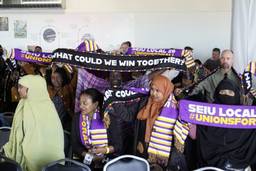This Land is Co-op Land
A hundred years ago, radical Finnish immigrants founded a cooperatively-owned park to escape political repression on Minnesota’s Iron Range. It’s still “a workingman’s paradise.”
Amie Stager

CHERRY, MINN. — I’m standing on the dock, watching sunlight reflect off the waves, when the sound of a bell calls my attention to the Finnish dance hall towering over the lakeshore. The mojakka—a Finnish beef soup — is ready. I head to the dining room with the dozens of other people who have gathered here at Mesaba Co-op Park for the annual midsummer festival, a weekend of live music, talent shows, maypole dancing and meals.
The park consists of more than 240 acres of land, including a spring-fed lake. Such places are usually owned and administered by a government or kept as private retreats by companies or rich people. Mesaba, in contrast, is neither privately nor government-owned, but collectively owned by members of a cooperative who foster relationships with each other and the land outside of corporate or government structures.
Co-op members call it “a workingman’s paradise.”
Located on Minnesota’s Iron Range — so named for the iron mines that dominate the landscape and local economy— Mesaba is a living monument to the region’s history of radical working-class struggle and community. It was founded by Finnish immigrants who brought their political traditions of collectivism, socialism and union organizing to the Midwest with them. The Iron Range saw its first widespread labor strike in 1907 after the Western Federation of Miners came in and organized 14 locals. In 1916, as wages stagnated and the cost of living rose, the miners went on a wildcat strike that was met with violent repression from police and company guards.
Because of their prominent role in the strikes, many Finnish miners were blacklisted from the mines and faced anti-Finnish discrimination in many public spaces, according to an article by historian Arnold Alanen.
They decided they needed a place to gather where they would “no longer be at the mercy of others,” as a park history pamphlet puts it. The Mesaba Range Co-operative Federation began to look for land that could accommodate festivals, campgrounds and a children’s camp.
In 1929, the group bought the park’s original 160 acres from a lumber company for $2,000.
Any Finnish-American organization was invited to join the cooperative, and by 1930 some 40 organizations owned shares. Early in the park’s history, the annual midsummer celebration was called the “Festival of Struggle.”

The park is also considered an epicenter of the Minnesota Farmer-Labor Party (which is why I was there; I joined the Farmer-Labor Education Committee in 2023). In July 1936, almost 10,000 people came to Mesaba Co-op Park — in what would turn out to be one of the largest political gatherings in the history of the Iron Range at that time — to hear speeches from Farmer-Labor Party political candidates Elmer Benson and John T. Bernard. The Farmer-Labor Party was part of a movement that spanned rural and urban areas in Minnesota to fight corporate greed and provide mutual aid. It was the state’s strongest alternative to the two-party system until 1944, when it merged with Democrats to create the Democratic-Farmer-Labor Party that Minnesotans know today.
“This place was always a flashing beacon for progressives,” says David Bednarczuk, resident mojakka maker and park historian. When Bednarczuk, who lives in Hibbing, joined the cooperative in the 1970s, he was one of the first members who did not speak Finnish. Part of a new generation of antiwar environmentalists, he helped reenergize the park after what he called a “lost generation” of members were subjected to FBI surveillance and political repression during the McCarthy era.
Today, members of the Mesaba Cooperative Park Association— educators, artists, trades workers, hospitality workers, historians, healthcare workers and railroad workers — continue to use the park for community gatherings. Most members aren’t Finnish, but the radical traditions of the working-class Finnish founders live on in the park itself, a remnant of a time when “cooperative commonwealth” clubs existed throughout the United States, including one led by socialist Eugene Debs that tried to establish cooperatives to serve as models of socialism.
That spirit of collectivism has faded from our national life, including here in Minnesota, where it’s largely been replaced by what I call the “Minnesota Dream” — the dream of owning lakeshore property up north, a kitschy cabin where you can escape the grind of city life and the hell of other people, an individualistic fantasy of peace and privacy and private property.
Mesaba Co-op Park represents a radical alternative to that Minnesota Dream. It embodies an economy that is based, instead, on cooperative ownership, collective decision-making and mutual thriving. It is, as Bednarczuk says, a beacon — a guiding light toward a different world that we might yet choose to live in.
Amie Stager is associate editor at Workday Magazine.
